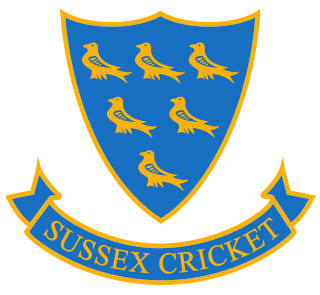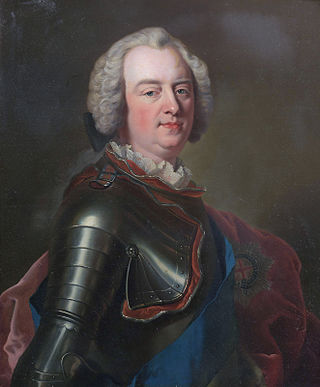Related Research Articles

Sussex County Cricket Club is the oldest of eighteen first-class county clubs within the domestic cricket structure of England and Wales. It represents the historic county of Sussex. Its limited overs team is called the Sussex Sharks. The club was founded in 1839 as a successor to the various Sussex county cricket teams,including the old Brighton Cricket Club,which had been representative of the county of Sussex as a whole since the 1720s. The club has always held first-class status. Sussex have competed in the County Championship since the official start of the competition in 1890 and have played in every top-level domestic cricket competition in England.

Charles Lennox,2nd Duke of Richmond,2nd Duke of Lennox,2nd Duke of Aubigny,of Goodwood House near Chichester in Sussex,was a British nobleman and politician. He was the son of Charles Lennox,1st Duke of Richmond,1st Duke of Lennox,the youngest of the seven illegitimate sons of King Charles II. He was the most important of the early patrons of the game of cricket and did much to help its evolution from village cricket to first-class cricket.
In the years from 1726 to 1750,cricket became an established sport in London and the south-eastern counties of England. In 1726,it was already a thriving sport in the south east and,though limited by the constraints of travel at the time,it was slowly gaining adherents in other parts of England,its growth accelerating with references being found in many counties. Having been essentially a rural pastime for well over a century,cricket became a focus for wealthy patrons and gamblers whose interests funded its growth throughout the 18th century.
Arthur Haygarth was a noted amateur cricketer who became one of cricket's most significant historians. He played first-class cricket for the Marylebone Cricket Club and Sussex between 1844 and 1861,as well as numerous other invitational and representative teams including an England XI and a pre-county Middlesex. A right-handed bat,Haygarth played 136 games now regarded as first-class,scoring 3,042 runs and taking 19 wickets with his part-time bowling. He was educated at Harrow,which had established a rich tradition as a proving ground for cricketers. He served on many MCC committees and was elected a life member in 1864.
William McLean Gifford is an English cricketer who has played first-class cricket for Loughborough UCCE and one List A game for Worcestershire. He is,as Wisden put it,"no known relation" to former Worcestershire captain Norman Gifford.
In English cricket,the years 1826–1845 were dominated by the roundarm bowling issue,which was resolved when the style was legalised in 1835,and by the formation of the first modern county clubs between 1839 and 1845.
In English cricket since the first half of the 18th century,various ad hoc teams have been formed for short-term purposes which have been called England to play against,say,Marylebone Cricket Club (MCC) or an individual county team. The key factor is that they were non-international and there is a significant difference between them and the official England cricket team which takes part in international fixtures. Conceptually,there is evidence of this sort of team being formed,or at least mooted,since the 1730s. They have always been "occasional elevens" but,nevertheless,have invariably been strong sides. A typical example would be a selection consisting of leading players drawn from several county teams.
County cricket teams representing Middlesex have been traced back to the 18th century,although for long periods the county was secondary to the London Cricket Club which played at the Artillery Ground. Middlesex teams played at various grounds throughout what is now the Greater London area. Islington and Uxbridge were often used but home matches were also played on Kennington Common and in Berkshire. Middlesex teams were less frequent in the 19th century until 1859 when the Walker family of Southgate became involved in county cricket.
The 1777 English cricket season was the sixth in which matches have been awarded retrospective first-class cricket status. The scorecards of six first-class matches have survived. James Aylward made a record score of 167 runs that stood until 1820.

The 1787 cricket season in England is noteworthy for the foundation of Marylebone Cricket Club (MCC) after the opening of Thomas Lord's first ground in the parish of Marylebone,north of London. MCC soon became the sport's governing body with the new ground as its feature venue. The first match known to have been played at Lord's was on Monday,21 May,between the White Conduit Club and a Middlesex county team. The first match known to involve a team representing MCC was against White Conduit on Monday,30 July. Including these two,reports and/or match scorecards have survived of numerous eleven-a-side matches played in 1787. Eleven are retrospectively,but unofficially,recognised as first-class.

Frederick William Lillywhite was an English first-class cricketer during the game's roundarm era. One of the main protagonists in the legalisation of roundarm,he was one of the most successful bowlers of his era. His status is borne out by his nickname:The Nonpareil.
Two English cricket teams toured Australia in 1887–88. They are generally known as A. Shrewsbury's XI and G. F. Vernon's XI. Shrewsbury's XI also visited New Zealand in March.
William Ayling was an English cricketer who played in 22 first-class cricket matches between 1800 and 1810.
Arthur William FitzRoy Somerset was an English first-class cricketer.
Oliver Gordon Battcock was an English cricketer,actor and producer. Battcock was a left-handed batsman who bowled right-arm medium pace. He was born in Slough,Buckinghamshire.
Matthew William Machan is an English-born former cricketer who played for Sussex and Scotland. Machan was a left-handed batsman who bowled right-arm off break. He was born in Brighton,Sussex and educated at Hurstpierpoint College and Brighton College. Machan currently plays for Brighton and Hove CC in the Sussex Premier League.
Thomas Gage Blake was an English cricketer. Blake's batting style is unknown,though it is known he fielded as a wicket-keeper. He was born at Midhurst,Sussex.
Alfred Smith was an English cricketer notable for his fourteen first-class cricket appearances for Sussex as a gentleman cricketer between 1841 and 1852.
Through the Napoleonic Wars,county cricket virtually died as cricket was impacted by losses of investment and manpower.